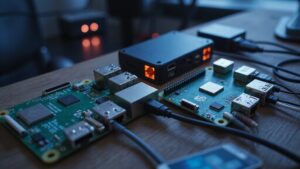Can you have Ethernet-based IoT Solutions with Raspberry Pi?
When you need reliable and low-latency data transport for real-time systems, Raspberry Pi’s Ethernet connectivity stands out compared to wireless options. You can leverage its native interfaces, expand with modules like WIZ850io, and securely integrate with industrial protocols. Scaling your IoT solutions with Raspberry Pi is straightforward thanks to robust wired networking. But ensuring efficient edge processing and true modularity raises essential architectural choices—factors you’ll want to explore before designing your next industrial IoT solution.
Key Takeaways
- Ethernet ensures reliable, high-speed, and low-latency connectivity for IoT deployments using Raspberry Pi, crucial for industrial and real-time applications.
- Native Gigabit Ethernet on Raspberry Pi models provides stable, secure network integration and simplifies scalable IoT system management.
- Modular expansion options support industrial protocols (CAN, RS-485) and dual Ethernet, enabling flexible, robust industrial IoT solutions.
- Ethernet-based Raspberry Pi solutions enhance data security with robust encryption, device authentication, and lower susceptibility to wireless attacks.
- Raspberry Pi with Ethernet supports industrial applications like soft PLCs, IoT gateways, and real-time data acquisition with uninterrupted, backup-protected operation.
Advantages of Ethernet Connectivity for IoT Applications
When designing scalable IoT systems, leveraging Ethernet connectivity delivers clear advantages in reliability, speed, and security that wireless alternatives often can’t match.
You’ll benefit from connection reliability—critical for applications demanding constant uptime and precise device management. Ethernet advantages include high-speed data transfer and low latency, so real-time communications and large data volumes are handled with ease. Wired connections reduce interference, offering a stable network environment that ensures devices maintain seamless communication even in noisy industrial settings.
Network security is heightened, using robust encryption, authentication protocols, and firewall protection to shield sensitive data. When deploying IoT solutions at scale, robust network architecture is essential to accommodate future expansion and maintain efficient data flow across devices.
Installation efficiency rises with Power over Ethernet, reducing cabling complexity and enabling flexible device deployment.
As you scale your IoT setup, Ethernet supports seamless integration and future proofing technologies, ensuring your infrastructure adapts to evolving standards and bandwidth needs.
This approach offers unmatched stability and interoperability for innovative, long-term IoT solutions.
Overview of Raspberry Pi Networking Capabilities
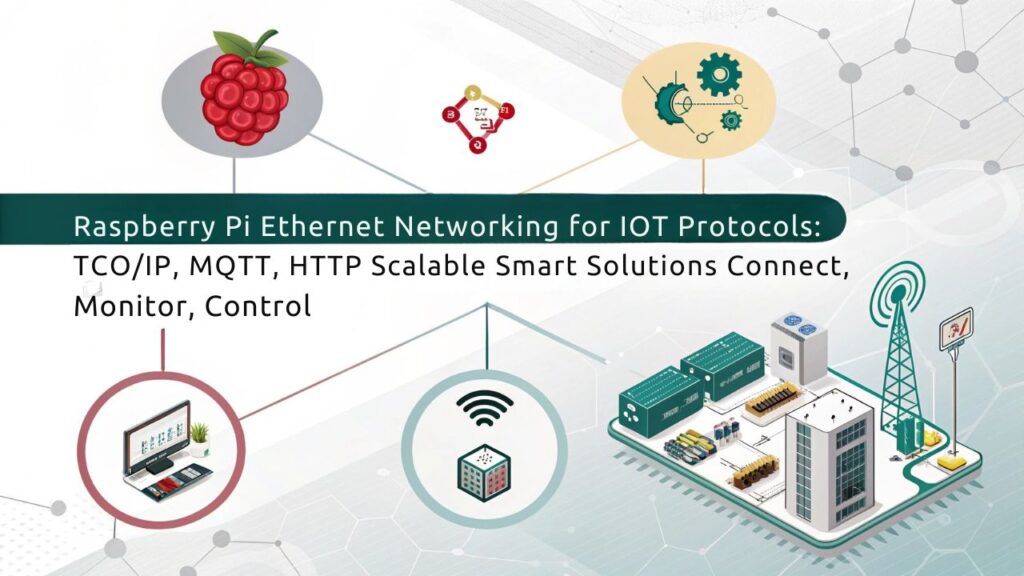
You can leverage the Raspberry Pi’s built-in Ethernet for stable, low-latency connections that support high-throughput industrial IoT deployments. While Wi-Fi offers installation flexibility, Ethernet consistently guarantees greater reliability and security for scalable system integration. With energy efficiency as a key advantage, utilizing Raspberry Pi for Ethernet-based networking minimizes power consumption in continuous industrial operations. Raspberry Pi OS uses DHCP by default for network interfaces, simplifying network setup and management in varied deployment environments.
Built-in Ethernet Benefits
Ethernet connectivity on the Raspberry Pi 4 transforms its networking capabilities, delivering native Gigabit speeds through a fully integrated controller on the Broadcom BCM2711 SoC.
With built in ethernet, you’ll experience marked performance enhancements thanks to direct SoC integration—no more dependence on external USB adapters that introduce bottlenecks and extra complexity. The Raspberry Pi 4’s energy-efficient design ensures optimal performance for always-on IoT applications without excess heat or noise. If you need low-level technical details, note that no public datasheet for the Broadcom Ethernet controller currently exists, but key information can be found through the official Linux drivers and community documentation.
This precision engineering directly benefits your IoT deployment efficiency and long-term scalability.
- Eliminate bulky external USB network adapters and streamline your hardware footprint.
- Native Gigabit Ethernet achieves stable, high-speed network throughput for robust IoT data flows.
- Reduced latency and improved responsiveness because Ethernet is fully integrated, not routed through USB.
- Reliable plug-and-play support in Raspberry Pi OS, eliminating manual driver setup.
- Lower system power draw and enhanced durability, critical for 24/7 IoT operations.
Wi-Fi Versus Ethernet
Although both Wi-Fi and Ethernet are integral to the Raspberry Pi’s networking arsenal, their capabilities align with distinct deployment priorities and constraints.
When you leverage Wi-Fi, you gain deployment flexibility, ideal for mobile or prototyping scenarios—but you must account for Wi-Fi interference and variable network stability, especially in congested environments. Robust wireless security configuration—WPA2, WPA3—is critical to guard against unauthorized access over the broadcast medium. As digital signal processing converts analog data into numbers for reliable wireless communication, understanding both analog and digital signal types is essential for effective Raspberry Pi networking.
Conversely, implementing Ethernet cabling provides assured network stability, predictable throughput, and physical layer security, making it preferable for production IoT use cases where reliability is paramount. Raspberry Pi models with Ethernet support can deliver consistent low-latency connections and are less susceptible to external RF disruptions, ensuring stable infrastructures for scalable, highly integrated solutions. Many network engineers take advantage of cost-effective network clients by using Raspberry Pi devices over Ethernet for reliable deployment and straightforward management.
Choose connectivity aligned with your system’s strategic requirements.
Industrial Networking Options
When industrial applications demand robust, scalable, and highly integrated networking infrastructures, the Raspberry Pi ecosystem delivers a versatile set of options engineered for rigorous environments.
You’ll find that Raspberry Pi’s networking capabilities support diverse network topology requirements and maximize device compatibility. Designed for easy integration with industrial systems, they offer dual Ethernet ports, wireless connectivity, and industry-standard interfaces. Designed with rigorous compliance testing in mind, Raspberry Pi devices meet essential certification requirements for seamless deployment in industrial settings. For ongoing support and technical insights, Raspberry Pi provides access to a web-based resource offering detailed documentation and compliance information.
You can deploy custom network configurations and scale seamlessly across multiple applications. Core networking components and devices include:
- Raspberry Pi Compute Modules for DIN rail mounting and compact industrial installations
- Strato Pi series with dual Ethernet and Wi-Fi for redundancy in network topology
- Integration with CAN bus, RS232/RS485 to connect legacy devices
- RevPi Connect 5 featuring multi-gigabit Ethernet for high-throughput networks
- WIZnet W55RP20 enabling streamlined development and device compatibility
Integrating WIZ850io and Custom Ethernet Modules

Seamless integration of the WIZ850io and similar custom Ethernet modules into Raspberry Pi-based IoT systems demands attention to both hardware alignment and software configuration.
Leverage WIZ850io compatibility by matching the module’s 3.3V logic levels and pinouts via SPI using jumper wires. The compact design advantages simplify enclosure choices for dense IoT deployments. The WIZ850io utilizes the W5500 chip, which is specifically engineered to provide reliable and high-speed ethernet connectivity for embedded applications. Testing Ethernet Module Driver is a critical step to verify that communication between the Raspberry Pi and Ethernet hardware is functioning as expected.
For software, you must engage in custom driver development—modifying Linux kernels and enabling device overlays like w5500.dtbo to guarantee proper recognition.
Activate relevant modules (w5100, w5100-spi) in your environment, then proceed with network interface configuration, choosing DHCP or static IP as necessary.
These steps make integrating Ethernet straightforward for both WIZ850io and custom SPI modules, supporting scalable, low-latency solutions in demanding embedded or industrial IoT applications.
Leveraging GPIO and Peripheral Protocols in IoT Deployments
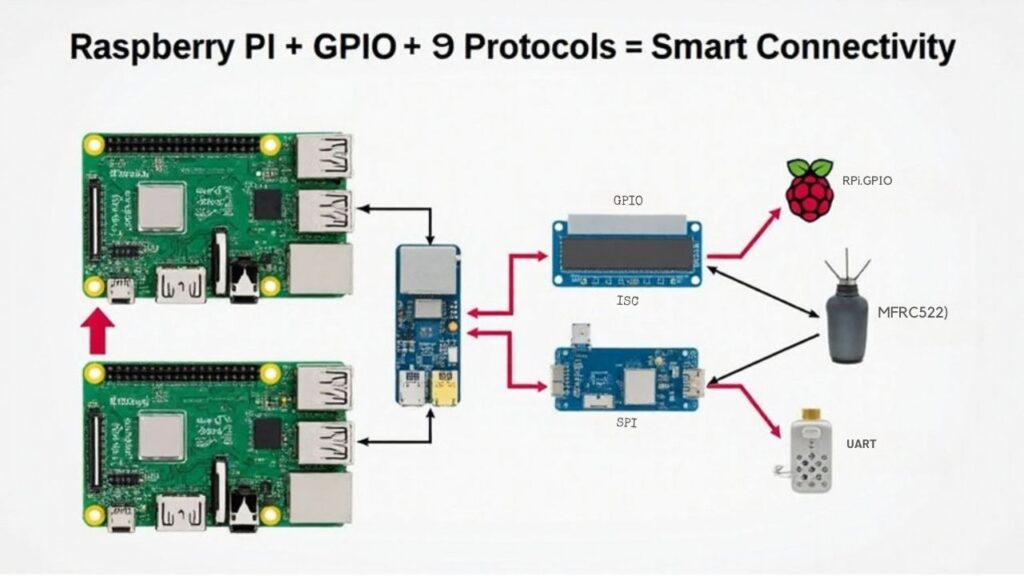
To maximize the versatility and scalability of your IoT deployments, you’ll need to leverage the Raspberry Pi’s GPIO pins and peripheral communication protocols strategically. Effective GPIO integration guarantees seamless sensor management and enables dynamic interactions with devices, such as RFID modules or environmental sensors. Protocol optimization using SPI, I2C, and UART strengthens device synchronization and accelerates data flow across your system. Using the appropriate sensors or devices ensures that your Raspberry Pi project is capable of addressing the specific problem you aim to solve. Python software libraries—including RPi.GPIO, GPIOD, MFRC522, and PySPI—streamline peripheral communication and abstract hardware complexities. Many library checkout systems rely on RFID technology, illustrating how Raspberry Pi can power innovative identification and lending solutions.
Consider these high-impact approaches:
- Connect LEDs or buttons using precise GPIO mapping for interactive controls
- Enable RFID tag reading over SPI for scalable identification systems
- Manage multiple sensors over I2C for robust data aggregation
- Optimize serial links using UART for device-to-device communication
- Deploy modular Python libraries for reliable protocol abstraction
Implementing MQTT and Edge Processing Over Ethernet
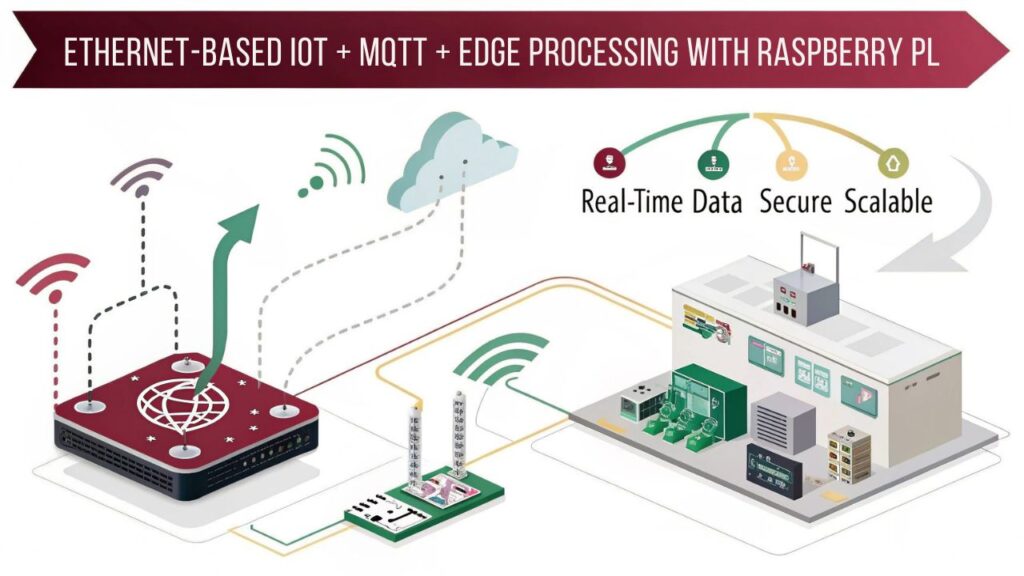
You can use Ethernet to guarantee reliable MQTT data transmission with minimal packet loss and robust delivery, especially in demanding IoT environments. By installing the Mosquitto MQTT broker on Raspberry Pi, you benefit from a simple, cost-effective, and energy-efficient way to manage MQTT traffic locally on your network. By processing analytics locally on devices like Raspberry Pi, you reduce latency and bandwidth requirements while maintaining scalable system performance. MQTT is agnostic to the physical infrastructure used for communication, which means Ethernet can be as effective as Wi-Fi for these solutions.
This approach lets you optimize both message reliability and real-time insights directly at the network edge.
Reliable MQTT Data Transmission
While managing large-scale IoT deployments, Ethernet provides a stable foundation for MQTT-based data transmission, enabling robust and real-time communication between edge devices and central brokers.
Leveraging Ethernet’s predictable latency, you can implement MQTT optimization strategies that strengthen end-to-end reliability and scalability. Three defined quality of service levels let you fine-tune message delivery based on the importance of different data flows. Emphasize QoS configuration best practices and message retention techniques to guarantee data integrity, even amid network interruptions.
Edge processing on a Raspberry Pi pairs perfectly with MQTT’s lightweight protocol advantages, delivering efficient network congestion management and enhancing real-time analytics applications. MQTT employs a publish/subscribe (Pub/Sub) pattern for communication, simplifying the management of many interconnecting devices in IoT networks. Boost security with MQTT security enhancements and adopt session persistence methods for uninterrupted data flows.
- Persist messages and sessions for seamless data delivery after outages
- Prioritize alerts via QoS-based routing
- Encrypt and authenticate data streams
- Preprocess sensors at the edge to reduce bandwidth
- Monitor network health through keep-alive intervals
Local Analytics for IoT
Building on robust MQTT data transmission over Ethernet, local analytics and edge processing on platforms like the Raspberry Pi introduce real-time intelligence directly at the data source.
By leveraging local data processing, you reduce latency and enable real-time analytics, allowing instant detection of anomalies or critical events. For remote or bandwidth-constrained deployments, keeping analysis and decision-making close to the endpoints ensures seamless operations even if central connectivity is limited.
MQTT’s lightweight publish/subscribe model facilitates rapid data exchange on Ethernet-connected edge nodes, empowering you to filter, cleanse, and aggregate sensor inputs right where they’re generated. Edge computing enables low-latency responses by processing data locally, which is essential for time-sensitive IoT applications and industrial systems.
This strategy alleviates bandwidth constraints and minimizes cloud costs by transmitting only refined, relevant information upstream.
Additionally, by implementing protocol translation and running MQTT brokers locally, your system achieves resilience and autonomous operation—even during network interruptions.
These scalable, modular approaches let you deliver actionable analytics and innovation, directly where decisions matter most.
Industrial Use Cases for Ethernet-Enabled Raspberry Pi Systems

Because Ethernet-enabled Raspberry Pi systems combine flexible hardware with robust software support, they’ve emerged as versatile building blocks in industrial automation.
You can deploy Raspberry Pi applications in a wide array of scenarios where scalability and integration matter most. Their compact design allows seamless installation, while broad protocol support and real-time Linux capabilities enable precise, reliable control.
In modern industrial automation, you’ll see these systems excel in:
- Rapidly reconfigurable soft PLC controllers in manufacturing lines
- Real-time data acquisition units logging critical sensor data
- IoT gateways bridging legacy equipment with IT systems
- Edge AI processors for on-site machine vision or predictive maintenance
- Modular data loggers enabling low-cost, scalable process monitoring
Embrace these use cases and reveal new efficiencies while modernizing your industrial operations with the adaptability of Ethernet-enabled Raspberry Pi solutions.
Enhancing Security and Real-Time Performance With Wired Connections
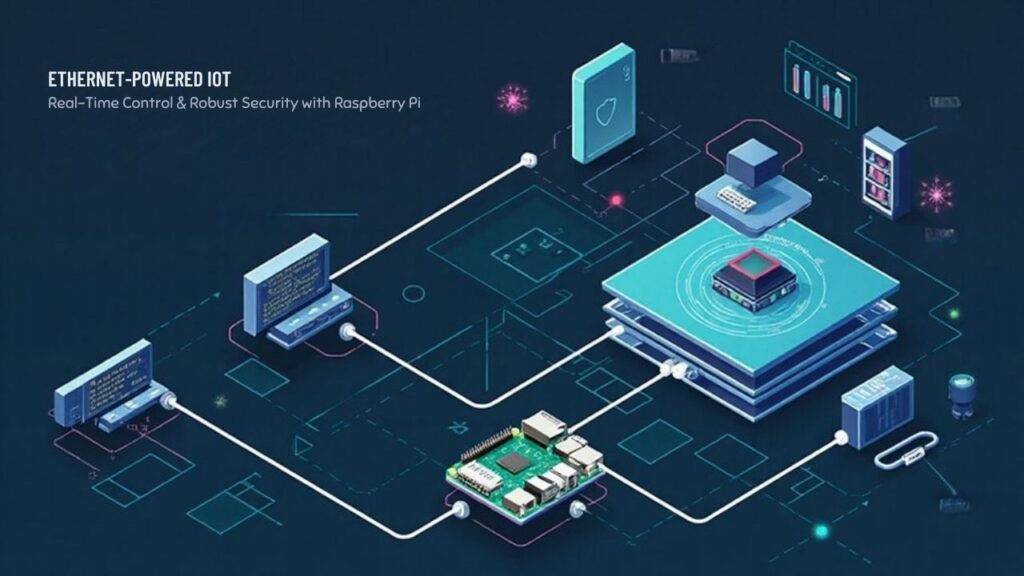
You can minimize network latency risks and strengthen data transmission security by leveraging dedicated Ethernet connections in your IoT deployments.
Integrating robust encryption protocols and implementing centralized firewall controls guarantees sensitive data remains protected throughout the system.
This approach scales efficiently for complex environments, providing both real-time responsiveness and a hardened security posture.
Minimizing Network Latency Risks
While wireless technologies remain popular for IoT deployments, Ethernet-based solutions address significant challenges in minimizing network latency and guaranteeing robust, real-time performance.
You optimize your IoT architecture by leveraging Ethernet’s predictable data transmission, vital for latency mitigation and bandwidth optimization. Wired connections deliver consistent speeds and lower error rates, essential for mission-critical and real-time applications.
When deploying a Raspberry Pi in industrial or edge environments, integrating Ethernet provides tighter control and maximized network reliability.
- Dedicated bandwidth guarantees your data streams avoid bottlenecks and delays.
- Predictable response times increase the reliability of time-sensitive IoT functions.
- Reduced congestion eliminates the unpredictability common in crowded wireless networks.
- Prioritized data delivery keeps mission-critical IoT information moving first.
- Intelligent topology designs streamline device-to-device communication for scalable expansion.
Strengthening Data Transmission Security
Although wireless connectivity offers flexibility, Ethernet-based IoT solutions deliver a superior foundation for secure data transmission and real-time reliability.
By connecting your Raspberry Pi over Ethernet, you greatly reduce exposure to wireless hacking risks like eavesdropping and signal interception. Physical cabling requires direct access, raising the bar for potential attackers and preserving data integrity.
You can implement robust secure protocols such as IEEE 802.1X for device authentication and use AES-128 or TLS encryption to prevent unauthorized access and maintain data confidentiality.
Power over Ethernet (PoE) further streamlines security, minimizing external adapters and optimizing physical protection.
Ethernet’s low-latency characteristics, combined with error correction and QoS features, enable scalable and trusted IoT networks—ensuring only authenticated devices exchange reliable, protected data, crucial for mission-critical and time-sensitive applications.
Modular Expansion for Industrial Protocol Support
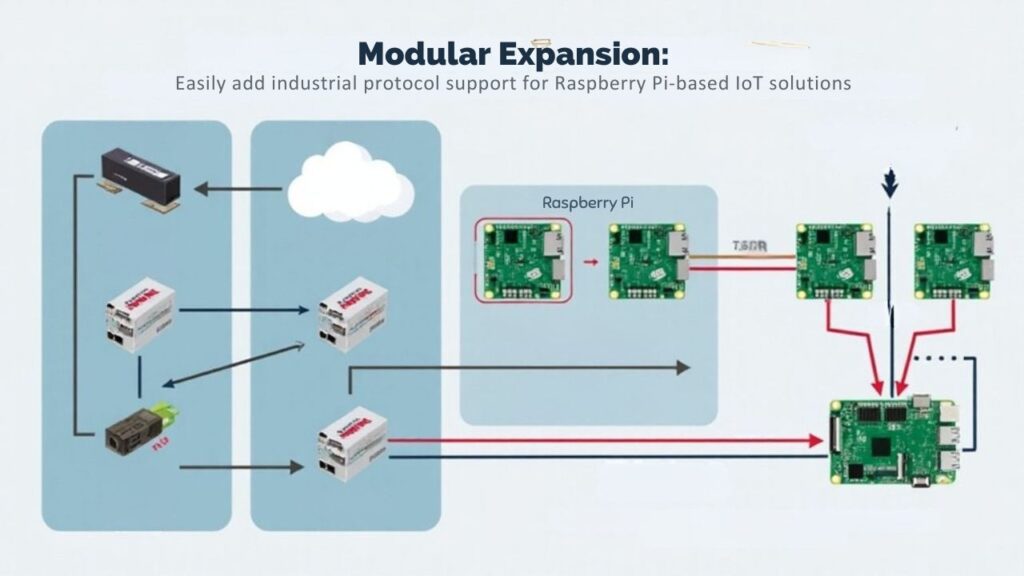
As industrial IoT deployments increasingly demand seamless integration with diverse legacy networks, modular expansion boards for platforms like Raspberry Pi offer a scalable approach to protocol adaptability.
By leveraging modular interfaces, you can expand communication capabilities to match the complexity of your industrial protocols. High-performance add-ons link the Raspberry Pi to CAN bus, RS-485, or RS-232, while opto-isolation shields your hardware from volatile environments.
Modular interfaces empower scalable connectivity—bridge your Raspberry Pi to CAN, RS-485, or RS-232, all while ensuring robust hardware protection.
Commercial solutions such as Strato Pi and Revolution Pi exemplify expandable, industrial-grade integration.
- Snap in a CAN bus HAT for real-time factory machine monitoring
- Embed RS-485 modules to support Modbus RTU on production lines
- Stack digital I/O expansions for sensor-rich automation
- Slot DIN rail-ready boards into control cabinets for streamlined wiring
- Combine secure elements and watchdog timers for protocol reliability
This modularity enables agile, protocol-agnostic IoT solutions.
Power Management and Reliability Considerations

Expanding industrial IoT solutions beyond protocol flexibility demands equally robust strategies for power management and reliability.
You’ll need reliable power supply options like UPS HATs for Raspberry Pi, which guarantee seamless switching between adapter and battery power without causing resets. These HATs integrate battery management features—charging regulation, current monitoring, and watchdog timers—for stable operation.
Choose input options spanning 5V–21V to support everything from mains adapters to solar setups. Implement backup batteries, such as protected 18650 Li-ion cells, to maintain runtime during outages and leverage I2C-connected APIs for real-time system feedback.
Optimize power consumption by using appropriate Raspberry Pi models, shutting down unnecessary peripherals, and activating sleep modes.
Battery protection circuits, overvoltage defenses, and safe shutdown protocols are essential to maximize uptime and safeguard data integrity.
Sample Architectures for Scalable Ethernet-Based IoT Solutions

Blueprints for scalable Ethernet-based IoT deployments prioritize modularity, robust network design, and seamless cloud integration.
When you’re building sample architectures with Raspberry Pi, you’ll want to combine edge computing, secure Ethernet protocols, and dynamic cloud resources for scalable solutions.
Focus on high-availability frameworks and integrate standard APIs for future-proof compatibility.
Here’s how a scalable, innovative system might look:
- Modular clusters of Raspberry Pi devices connected via secure Ethernet for horizontal scaling.
- Redundant switches and failover network paths to guarantee uninterrupted data flows.
- Edge computing nodes performing real-time analytics and data filtering before pushing to the cloud.
- Cloud platforms dynamically allocating compute resources and enabling centralized device management.
- Asynchronous, secure communication protocols (MQTT/SSL) ensuring efficient, prioritized data exchange.
Leverage these structures for resilient, growth-ready solutions.
Frequently Asked Questions
How Do I Set up Network Monitoring on Ethernet-Connected Raspberry Pi Devices?
To set up network monitoring, connect your Raspberry Pi via Ethernet, install monitoring tools like ntopng and Wireshark, and configure them to analyze network traffic. You’ll achieve scalable network insights, enabling precise analysis and innovative system integration.
Can Power Over Ethernet (Poe) Be Used With Raspberry Pi for IoT?
You can leverage PoE advantages like streamlined cabling and simplified power management with compatible Raspberry Pi models using official PoE HATs. This integration enhances scalability and system reliability, making deployment and maintenance far more efficient for innovative IoT projects.
What Troubleshooting Steps Help Diagnose Ethernet Connectivity Issues on Raspberry Pi?
To diagnose Ethernet issues, you’ll run ping tests, perform cable checks, and review Raspberry Pi logs. Troubleshoot DHCP, verify static IP settings, validate network hardware, and execute speed tests to guarantee scalable, reliable connectivity for your innovations.
How Is Device Firmware Updated Remotely Over Ethernet in IoT Deployments?
You effortlessly keep things humming by leveraging remote updates for smooth firmware management. Devices securely download and validate new firmware from servers, install enhancements, and can roll back if needed—ensuring your IoT system stays scalable and seamlessly integrated.
Are There Recommended Enclosure Options for Outdoor Ethernet-Based Raspberry Pi IoT Solutions?
You should choose weather resistant enclosures with IP65 ratings, integrated cable grommets, and thermal management solutions like metal heatsink cases. This approach guarantees scalable, innovative system integration and protects your outdoor deployments against environmental and thermal challenges.
Conclusion
You’ve seen how Ethernet and Raspberry Pi create a future-proof, scalable backbone for industrial IoT—think of it as upgrading from carrier pigeons to fiber-optic. By integrating robust networking, edge computing, and secure protocols, you guarantee real-time responsiveness and rock-solid data integrity. With modular expansion and energy efficiency, you’re not just solving today’s challenges; you’re ready for tomorrow’s demands. Embrace wired connections—your IoT deployment will run like clockwork in the digital age.

I am a retired software engineer with experience in a multitude of areas including managing AWS and VMWare development environments. I bought a relative a mini-PC a year ago and have become passionate about the technology and its potential to change how we deploy software.

